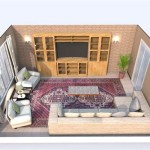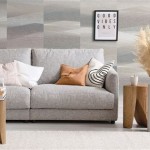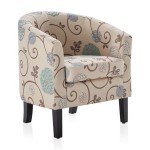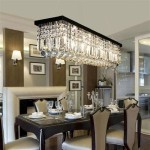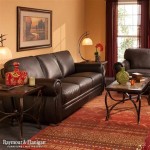Accent Wall Colors for the Living Room: A Comprehensive Guide
The living room serves as a central gathering space in many homes, demanding an environment that is both inviting and reflective of personal style. An accent wall, strategically painted in a contrasting color, can dramatically transform the room's aesthetic, adding depth, visual interest, and a touch of personality. Selecting the right accent wall color is crucial, as it can impact the overall mood and ambiance of the space. This article provides a comprehensive guide to choosing accent wall colors for the living room, considering various factors such as room size, lighting, and existing decor.
Before diving into specific color recommendations, it is essential to understand the fundamental principles that govern color selection in interior design. Color psychology plays a significant role, as different colors evoke distinct emotions and associations. For instance, cool colors like blues and greens tend to create a calming and serene atmosphere, while warmer colors like reds and oranges often convey energy and excitement. Furthermore, the interplay of light and shadow can significantly alter the perceived color, influencing the overall look and feel of the room.
Understanding Room Dynamics
The size and layout of the living room are primary considerations when selecting an accent wall color. In smaller rooms, it is generally advisable to avoid overly dark or saturated colors, as these can make the space feel even more confined. Lighter shades and muted tones tend to be more effective in creating an illusion of spaciousness. Conversely, in larger living rooms, bolder and deeper colors can be used to create a sense of intimacy and definition.
The function of the accent wall should also be considered. If the intention is to highlight a particular architectural feature, such as a fireplace or a built-in bookshelf, a color that contrasts sharply with the surrounding walls is often ideal. Alternatively, if the goal is to create a subtle backdrop for artwork or furniture, a more subdued and complementary color may be more appropriate. The wall's location within the room is also important. A wall that receives ample natural light can handle darker colors more effectively than a wall that is situated in a dimly lit corner.
Consider the existing color palette of the living room. The accent wall color should harmonize with the other colors present in the space, including the main wall color, furniture upholstery, and flooring. A cohesive color scheme will create a visually pleasing and balanced environment, while a poorly chosen color can disrupt the overall harmony of the room.
Exploring Color Options and Their Impact
Numerous color options are available for accent walls, each offering a unique aesthetic and emotional impact. Understanding the nuances of different colors and their potential effects is crucial for making an informed decision. The following outlines some popular color choices and their typical associations:
- Blue: Blue is often associated with tranquility, calmness, and serenity. It can create a relaxing ambiance, particularly in shades like powder blue, sky blue, or teal. Darker blues, such as navy or indigo, can add a touch of sophistication and drama. Blue is a versatile choice that works well in various living room styles, from coastal to contemporary.
- Green: Green symbolizes nature, growth, and harmony. It can bring a sense of freshness and vitality to the living room. Lighter greens, such as mint or sage, are calming and refreshing, while darker greens, such as forest or emerald, are more grounding and sophisticated. Green pairs well with natural materials like wood and stone.
- Gray: Gray is a neutral color that provides a sophisticated and versatile backdrop. It can range from light and airy to dark and moody, depending on the specific shade chosen. Gray is a popular choice for modern and minimalist living rooms. It can be combined with pops of color to add visual interest or used as a subtle backdrop for artwork and furniture.
- Yellow: Yellow is associated with optimism, energy, and happiness. It can brighten up a living room and create a cheerful atmosphere. However, it is important to use yellow sparingly, as too much can be overwhelming. Muted yellows, such as mustard or gold, are often more suitable for accent walls than bright, saturated yellows.
- Orange: Orange is a warm and vibrant color that can add a sense of energy and excitement to the living room. It is often associated with creativity, enthusiasm, and playfulness. Similar to yellow, orange should be used with caution, as it can be overpowering in large doses. Terracotta or burnt orange are more subdued options that can create a cozy and inviting atmosphere.
- Red: Red is a bold and passionate color that can add a touch of drama and intensity to the living room. It is associated with energy, excitement, and love. Red is best used as an accent color, as too much can be overwhelming or even anxiety-inducing. A deep crimson or burgundy can create a sophisticated and luxurious feel.
- Purple: Purple is often associated with royalty, creativity, and spirituality. Lighter purples, such as lavender or lilac, can create a calming and romantic atmosphere, while darker purples, such as eggplant or plum, are more dramatic and sophisticated. Purple pairs well with metallics like gold and silver.
Beyond these core colors, consider trending color palettes and seasonal influences. For example, earthy tones like terracotta and ochre are often popular during the fall and winter months, while brighter, more vibrant colors may be preferred during the spring and summer.
Factors Influencing Color Perception
The way we perceive color is influenced by several factors, including lighting, surrounding colors, and personal preferences. It is crucial to consider these factors when selecting an accent wall color to ensure that the final result aligns with the desired outcome.
Lighting: Natural and artificial lighting can significantly alter the appearance of colors. Natural light tends to make colors appear brighter and more vibrant, while artificial light can cast a yellowish or blueish hue, depending on the type of bulb used. It is essential to test paint samples in the living room at different times of day to see how the color appears under various lighting conditions. Consider both the amount and direction of light entering the room.
Surrounding Colors: The colors surrounding the accent wall can also influence its perceived color. Colors that are close together on the color wheel, such as blue and green, tend to harmonize well, while colors that are opposite each other on the color wheel, such as blue and orange, create a high-contrast effect. It is important to consider the existing color palette of the living room when selecting an accent wall color to ensure that it complements the other colors present in the space. You can use a color wheel to help visualize these relationships.
Personal Preferences: Ultimately, the best accent wall color is one that resonates with the homeowner's personal style and preferences. It is important to choose a color that makes the living room feel inviting, comfortable, and reflective of the homeowner's personality. Consider the overall mood and atmosphere that is desired for the living room and select a color that helps to achieve that goal. Do not be afraid to experiment with different colors and combinations to find the perfect fit.
In conclusion, careful consideration of room dynamics, color impact, and influencing factors is paramount when selecting an accent wall color for the living room. By thoughtfully evaluating these elements, homeowners can transform their living space into a visually appealing and personally expressive environment. Remember to test paint samples in the room under different lighting conditions and to consider how the color interacts with the existing decor and furniture. The goal is to create a cohesive and harmonious space that reflects personal style and enhances the overall living experience.

How To Choose An Accent Wall And Color Options The Artisen

Top 9 Accent Wall Colors To Add Dimension Your Space Decorilla Online Interior Design

Accent Wall Colors Design Guide Walls In Living Room Dark Blue

The Best Dark Statement Accent Wall Paint Colors For Your Home

Choosing The Right Color For Your Accent Wall

Accent Walls The Ultimate Guide Color Concierge

How To Choose The Perfect Accent Wall 360 Painting

Budget Friendly Accent Wall Ideas To Transform Any Room Walls In Living Bedroom Accents
Picking An Accent Wall Color Home Works Painting

Living Room Paint Ideas With Accent Wall Wandfarben Ideen Wohimmer Design Schlafzimmer

